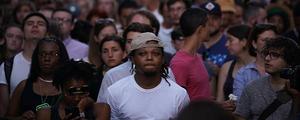Story Highlights
- Experiences vary by school, certificate and student body composition
- Perceived discrimination higher in certificate programs, private for-profit schools
- Diversity of student body a key factor in experiences with discrimination
WASHINGTON, D.C. -- About one in five (21%) Black postsecondary students say they “frequently” or “occasionally” feel discriminated against at their institutions -- a higher rate than the 15% reported for all other postsecondary students.
Experiences with racism vary greatly for Black students, based on the type of program they attend, the type of school and the racial diversity of the institution.
The Gallup Center on Black Voices has previously published findings on discrimination Black Americans experience at work, in receiving care and in daily life. Such negative experiences can take a toll on the victims. A new analysis from the Gallup-Lumina report, “Balancing Act: The Tradeoffs and Challenges Facing Black Students in Higher Education,” sheds light on the Black experience in postsecondary education.
One in Three Report Discrimination at Short-Term Certificate Programs
Reports of discrimination are higher among those in short-term credential programs -- including certificates and professional certifications -- where about one in three (32%) Black learners say they frequently or occasionally feel discriminated against. This rate is about twice as high as reports of discrimination among Black students in associate (16%) and bachelor’s (14%) degree programs.
Learners at Private For-Profit Schools Most Likely to Report Discrimination
One in three Black learners at for-profit private schools (34%) say they experience discrimination frequently or occasionally, compared with 23% of those in private not-for-profit institutions and 17% at public universities.
This finding is especially concerning because Black students make up a larger share of the student population in private for-profit institutions than in public or private not-for-profit universities.
Discrimination Most Common in Least Diverse Academic Programs
Black learners are more likely to feel discriminated against at institutions with the least racially diverse student bodies. Among schools that score in the bottom quintile on the Simpson racial diversity index (the least racially diverse student bodies), Black students are more likely than students in other quintiles to say they frequently or occasionally feel discriminated against.
Additionally, Black students in the least diverse student bodies are more likely to say they feel disrespected and physically or psychologically unsafe.
Discriminated Students Commonly Consider Stopping Out
One effect of discrimination is that it often leads to students considering leaving their studies. Black students who report frequent or occasional experiences with discrimination (61%) are far more likely than Black students who report few or no experiences (38%) to say they have considered stopping their coursework in the past six months.
Bottom Line
Black students at large are more likely than others to report experiences with discrimination in higher education, though certain academic paths are more laden with these experiences than others. The implications of these experiences are dire for many students: Most Black learners who report experiencing discrimination with frequency have considered stopping out of school altogether.
Short-term credential programs have become increasingly popular in the U.S., providing accessible pathways to additional education and training with lower financial and time investments. But the greater reports of experiences with discrimination among Black learners call into question the safeguards against systemic discrimination in these programs.
Students’ experiences with discrimination may in some cases suggest a need for greater regulatory oversight. For example, some advocacy organizations have called for greater accountability measures that prevent for-profit colleges from targeting minority communities with inferior program quality and predatory lending practices.
The diversity of a student body is a key factor in student experiences. Staff and students at institutions with fewer students of color may be less likely to adhere to norms of inclusivity and racial tolerance.
Learn more about how the Lumina Foundation-Gallup State of Higher Education 2022 study works.




